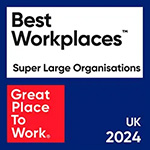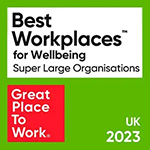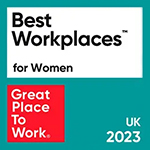February’s ‘Monthly Horizon’ Work+Family News
Author: Jennifer Liston-Smith, Head of Thought Leadership
As 2022 began, against a stormy backdrop of ‘party politics’, scientists reported sight of the ‘peak of omicron’: not a feature on the surface of the moon, but the tipping point leading to the easing of pandemic restrictions, across the nations of the UK. This moves us toward living with the novel coronavirus as an endemic and - for the vaccinated - a less deadly virus; unless a vaccine-resistant strain emerges.
With this, comes our latest (of many) opportunity to figure out new working styles in earnest; to define ongoing working arrangements, rather than crisis management. Google is amongst those backing the office as the best place for people to collaborate, grow and deliver work together. Our just-released Bright Horizons 2022 Modern Families Index shows a strong need for employers to get things right on both family support and flexible working, and also shows a slight trend back towards more time in the office, vs home.
Qualtrics meanwhile, ties up survey results from 14,000 workers around the world into a ‘Letter’ thanking their employers for all the support during the pandemic and then ‘tearing up the playbook’ in terms of expectations regarding future flexibility and autonomy. A 4-day week pilot programme being trialled by 30 UK employers should yield helpful insights as to whether 80% hours on 100% pay could enhance productivity in the longer term (beyond the initial flurry of gratitude). In another survey, by workingmums.co.uk and The Changing Work Company, over 2/3 of people who worked remotely pre-covid have not been asked about their experience even though it could shape new ways of working. The WM People Top Employer Awards ceremony took place showcasing innovations in flexibility, support for work-life fit, wellbeing and career progression. This certainly seems to be a time for consulting people on what works and measuring outcomes together.
Misconceptions about working alongside children
Kitty Holland, writing in the Irish Times about the potential gendered impact of remote working, did working parents a courtesy by including two case studies pointing out that remote workers do actually need, and use, childcare. A useful jolt for those who have become so used to seeing crazed images of homeworkers with children sitting on their shoulders, that they imagine all the remote working that has gone on for years before covid was done without care or education in the mix. Try typing ‘working parent remote working’ into a search engine. That’s really not how it is, outside of a pandemic.
Understanding that remote workers do not usually have a child on their lap all day did not stop a tweet about a lovely parent & baby desk in a Virginia library going viral. Social media threads made leaps from an hour in the library to a day at the office, with heated views on all sides, and several mentions that surely a workplace nursery might be a better option. Speaking of which - and with all eyes on the high cost of living - Bright Horizons’ upcoming webinar about Care Solutions in The Hybrid Working World shares vital information about the cost-neutral way employers can help employees save money on childcare through partnerships with local nurseries. This will bring even more savings if the rise in National Insurance goes ahead.
Parental Leave is a top-scoring requirement
Research by Vodafone has found that ‘one-in-five younger workers in the UK have quit their job due to poor parental leave support’ and that ‘A quarter of 18–34-year-olds did not apply for a job as a result of a perceived lack of support for parents’. Our 2021 Parental Leave Benchmark could be a helpful guide to what ‘good’ looks like.
Professional female footballers however will now have contractual maternity leave and cover, though with 14 weeks of paid leave and most stopping play at 3 months, it is regarded by some as just a start.
A Boost for Carers
Any carers waiting for a covid booster vaccination might be glad to have this link shared by our friends at Carers UK, who campaigned for this recognition. It requests priority access for unpaid carers (as well as for care workers).
Another recognition of carers is expected during 2022 with the Employment Bill. Announced at the end of 2019, delayed during the pandemic, and now expected to emerge in 2022. This is set to bring in statutory carer’s leave, giving employees with caring responsibilities one week of unpaid leave per year, whatever their service length.
This is the same Bill that is also due to introduce statutory neonatal leave and pay, for parents whose babies need neonatal care; and to extend the redundancy protection period for employees on maternity and similar leave to up to six months after they return to work.
As many, though not all, carers are themselves older workers, better recognition of, and provision for carers could play a part in stemming the Great Retirement.
Around the World
The gender pay gap and female workforce participation are proving hard to influence in both the Netherlands and India. Workplace culture and better division of household work are seen as part of the Dutch solution, while in India, there are calls for better government-funded support for maternity leave and crèche facilities, as well as gender-neutral leave.
The Australian state of New South Wales is providing a modest payout of 500 AUD to support parents with out of school care, as classes resume, recognising the ‘tough times’ parents have had. It’s another global indication that the daily juggling act of working parents managing the mismatch of the school day and work day is now better understood having been played out on camera.
In the US, President Joe Biden is attempting to get support from business leaders to get elements of his Build Back Better package back on track after it was stalled at the end of 2021. It’s possible that the package will be broken up and that climate commitments might pass more easily than provisions for families and care, despite their pivotal role in retaining much-needed female talent. Another in a long line of professions highlighted as losing women is medicine, with high reported rates of burnout and a traditional lack of flexibility.
In the UK and everywhere around the world, there are celebrations now for the lunar new year. We move from the Ox to the Tiger. While ‘Oxen are the hard workers in the background, intelligent and reliable, but never demanding praise’ Tigers are ‘courageous and active’ and ‘love a good challenge and adventure in life’. Hopefully some energy is in the air then, to continue tackling these interesting times in which we live.




